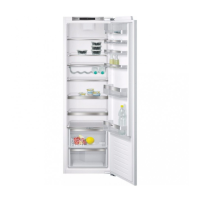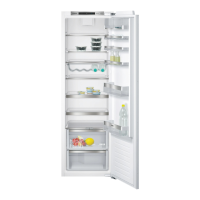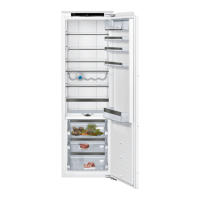Do you have a question about the Siemens KI81RAF30G and is the answer not in the manual?
Guide on reading and following operating and installation instructions for safe appliance use.
Warnings against using electrical devices or storing flammable substances inside the appliance.
Precautions regarding damaged power cords, proper repairs, and using original parts.
Warning about potential bursting of carbonated drink containers.
Information on the flammable refrigerant R600a and necessary precautions.
Measures to protect children and individuals with limited abilities from appliance hazards.
Safety advice on keeping keys away from children and keeping them from packaging.
Tips to prevent appliance damage, like not standing on the base or blocking vents.
Note on the appliance's significant weight during installation and transport.
Instructions for using the appliance solely for refrigerating food in a home environment.
Guidance on environmentally friendly disposal of recyclable packaging materials.
Information on reclaiming valuable raw materials through recycling of old appliances.
List of items included in the appliance delivery, including user manual and installation instructions.
Information regarding refrigerant, capacity, and other technical details found on the rating plate.
Guidelines for selecting an appropriate installation location considering room size and refrigerant.
Details on acceptable ambient temperatures for optimal appliance functionality based on climatic class.
Advice on the recommended cavity depth for efficient appliance installation and operation.
Recommendations for reducing power consumption during appliance installation and usage.
Steps to prepare the appliance before its initial operation, including cleaning and connection.
Instructions and precautions for connecting the appliance to the power supply safely and correctly.
Overview of the appliance's main parts and their functions, referencing diagrams.
Explanation of the buttons and displays on the control panel for operating the appliance.
Description of shelves, containers, and their adjustability within the appliance.
Instructions for switching the appliance on, setting temperatures, and basic operational tips.
Procedures for safely switching off and disconnecting the appliance from the power supply.
Guidance on adjusting and confirming the desired temperature for the refrigerator compartment.
Explanation of the Super Cooling feature for rapid chilling and its operation.
Information on the door alarm feature, its activation, and how to switch it off.
Best practices for storing various food items to maintain freshness and prevent flavour transfer.
Explanation of different temperature zones within the compartment for optimal food placement.
How to use and adjust the vegetable container for extended fruit and vegetable freshness.
Information about the automatic defrosting process and condensation management.
Step-by-step instructions for cleaning the appliance and its removable parts.
How to clean the condensation channel and drainage hole to prevent odours and blockages.
Specific instructions for removing and cleaning shelves, including the one above the vegetable container.
Steps to take if unpleasant odours occur, including cleaning and food sealing.
Details about the maintenance-free LED light and authorized repair procedures.
Descriptions of common sounds like droning, bubbling, clicking, and cracking during operation.
Tips to minimize or eliminate noises caused by appliance leveling or item placement.
Troubleshooting steps for significant deviations between set and actual temperatures.
Solutions for when displays do not illuminate or indicate errors like 'E...'.
How to respond to audible warning signals and illuminated alarm buttons.
Troubleshooting steps for situations where the appliance is not cooling, including showroom mode.
Information on contacting customer service for repairs and advice on common faults.
How to run the appliance's self-test program to identify faults for customer service.
Details on warranty periods and conditions available from customer service or the dealer.
| Door hinge | Right |
|---|---|
| Display type | LED |
| Product color | White |
| Reversible doors | Yes |
| Shelves material | Tempered glass |
| Appliance placement | Built-in |
| Door panel included | No |
| Fridge door balconies | 6 |
| Number of vegetable drawers | 2 |
| Fridge number of shelves/baskets | 7 |
| Current | 13 A |
| Connected load | 90 W |
| AC input voltage | 220-240 V |
| AC input frequency | 50 Hz |
| Annual energy consumption | 116 kWh |
| Noise level | 37 dB |
| Certification | VDE |
| Climate class | SN-T |
| Fridge net capacity | 319 L |
| Fridge gross capacity | - L |
| Cord length | 2.3 m |
| Depth | 545 mm |
|---|---|
| Width | 558 mm |
| Height | 1772 mm |
| Weight | 68000 g |
| Installation compartment depth | 550 mm |
| Installation compartment width | 560 mm |
| Installation compartment height | 1775 mm |











